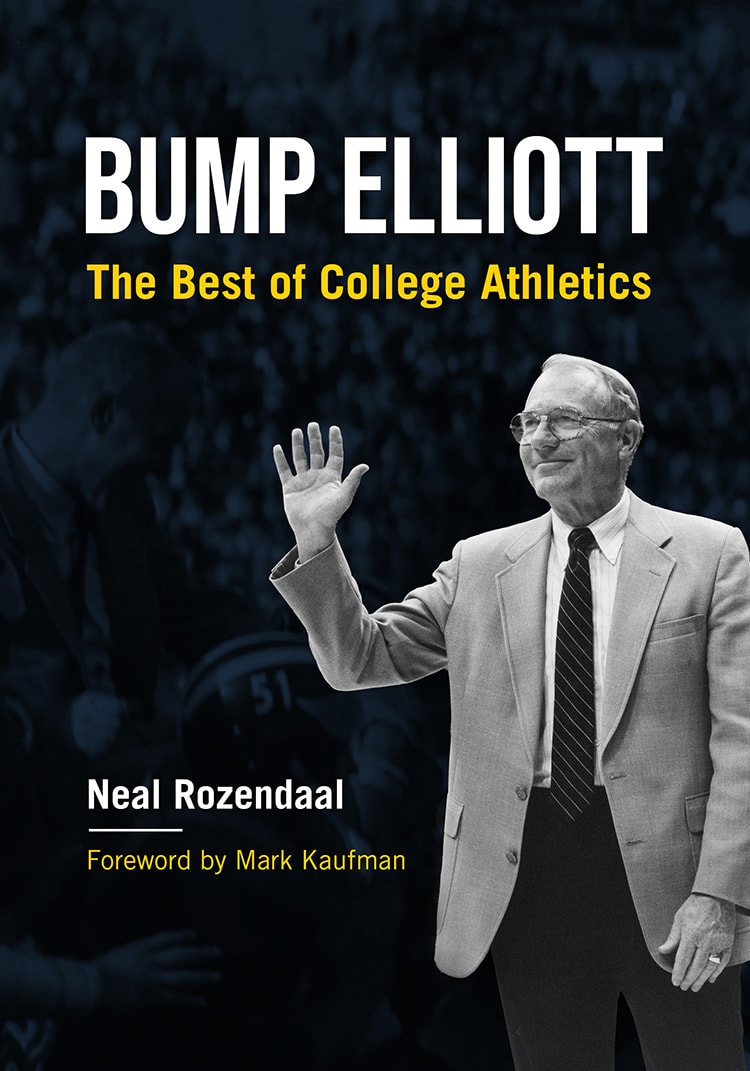 By J.O. Parker Chalmers William “Bump” Elliott, a longtime athletic director at the University of Iowa and a former coach and player at two other Big 10 schools, is the only man in history to participate in the Rose Bowl in five different capacities - player, assistant coach, head coach, assistant athletic director and athletic director. “He has a pretty amazing story,” said Neal Rozendaal, a Washington, D.C.-based author who just released the biography, Bump Elliott: The Best of College Athletics, last month. Born in Detroit on Jan. 30, 1925, and raised in Bloomington, Ill., Bump enlisted in the United States Marine Corps as a senior in high school and was assigned to the V-12 Training Program at Purdue University, where he played and received varsity letters in football, baseball and basketball. Bump left Purdue to serve a stint in China with the Marines during World War II. When he returned to the states, Bump enrolled at the University of Michigan, joining the football team where his brother, Pete Elliott, played quarterback. Bump starred for the undefeated 1947 Wolverine football team known as the “Mad Magicians,” a team that won the 1948 Rose Bowl. Bump led the Big 9 Conference in scoring, won the Chicago Tribune Silver Football as the conference’s Most Valuable Player and was selected as a first-team All-American by the American Football Coaches Association. He was inducted into the College Football Hall of Fame in 1989. After graduating from Michigan in 1948, Bump spent 10 years as an assistant football coach at Oregon State, Iowa and Michigan before being named Michigan’s head football coach in 1959. He led the Wolverines to a Big 10 championship in 1964 and a victory in the 1965 Rose Bowl. Bump retired from coaching in 1968 and was the associate athletic director at Michigan for a little over a year before landing in Iowa. Bump Elliott is best remembered in Iowa for spending 21 years as the men’s athletic director at the University of Iowa, hiring such coaches as Dan Gable, Hayden Fry, Lute Olson and Dr. Tom Davis. During Bump’s tenure at Iowa, the Hawkeyes won 30 Big 10 conference championships and 12 NCAA titles. “He is, in my opinion, the most important figure in Hawkeye athletics over the last 50 years,” noted Rozendaal, who spent five years writing the book. Rozendaal, a lifelong Hawkeye sports fan, is a 1998 graduate of Lynnville-Sully High School and a 2002 graduate of Iowa, where he holds degrees in economics, statistics and political science. He is the son of Bill and Norma Rozendaal of Grinnell. He has spent the last 18 years working for the Bureau of Labor Statistics in Washington, D.C. Rozendaal started writing articles about the Hawkeyes for online publications in 2005. Two years later, he had a chance meeting with Lyle Hammes, who was writing a book on the Hawkeyes. “I started talking with him and wound up becoming his co-author on our first book, Hawkeye Greats, By the Numbers,” Rozendaal said. Hawkeye Greats, which was self-published and released in October 2010, covers the best Hawkeye football and men’s basketball players to wear jersey numbers 1 through 50. It features such greats as Tim Dwight (#6), who played in the NFL and a Super Bowl with the Atlanta Falcons; Duke Slater (#15), the first African-American player elected to the College Football Hall of Fame; Nile Kinnick (#24), in whose honor Iowa’s football stadium is named; and Chris Street (#40), the Hawkeye basketball player who was tragically killed in a car accident in 1993. A year later, Rozendaal co-authored What It Means to Be a Hawkeye with Hammes and Michael Maxwell. Published by Triumph Books, it became a best-selling college football book on Amazon.com shortly after its release. The book came about when Hammes sent a copy of Hawkeye Greats to Triumph Books, a company that specializes in sports books. “They (Triumph) had an idea for a book of their own and needed someone to write it,” said Rozendaal. “They liked Hawkeye Greats so much, they asked us to write it.” What It Means to Be a Hawkeye is a collection of interviews with Hawkeye football players covering nine decades, from the 1930s through the 2010s. “We interviewed the two then-living teammates of Nile Kinnick for that book. We also interviewed Ricky Stanzi from the 2010 Hawkeye team and players from almost every year in between,” Rozendaal recalled. “We just asked all these players about their experiences and what it meant to them to be a Hawkeye.” His third book, Duke Slater: Pioneering Black NFL Player and Judge, is a biography of Fred “Duke” Slater, a legendary African-American football player at Iowa and in the NFL. “I had written a chapter on Duke Slater in Hawkeye Greats,” said Rozendaal. “I became so fascinated by his story that I wrote his biography.” Published in July 2012 by McFarland & Company, a small academic press, Duke Slater tells the story of Slater, who played for the Hawkeyes from 1918-21 and was a key member of Iowa’s 1921 national championship team. He joined the NFL the following year, becoming the first African-American lineman in league history. Slater played 10 seasons in the NFL for the Rock Island Independents and the Chicago Cardinals, picking up seven all-pro selections along the way. Slater earned his law degree in 1928 and began practicing law in Chicago. In 1948, he was elected to the Cook County Municipal Court, becoming the second African-American judge in Chicago history. He served as a judge for nearly two decades until his death in 1966. Slater was elected to the College Football Hall of Fame in 1951 and the Pro Football Hall of Fame’s Centennial Class in 2020. This fall, the University of Iowa named the field at Kinnick Stadium “Duke Slater Field” in his honor. Rozendaal published his fourth book, The Women’s Football Encyclopedia, in January 2016 under his own imprint, Rozehawk Publishing. Rozendaal said his wife Ashley was an exceptional college athlete, throwing the discus and hammer for George Mason University. After they married in 2012, Ashley played two seasons with the D.C. Divas, a premier women’s club football team. “Watching Ashley and the Divas, I greatly admired how hard these women worked at playing the traditionally male sport of football, all while getting none of the glory,” Rozendaal observed. The Women’s Football Encyclopedia chronicles the history of women playing the sport of football. “After writing so much about the Hawkeyes, researching the history of women’s football was a really fun digression for me,” Rozendaal said. With five books under his belt, Rozendaal said he doesn’t know the topic of his next book. “I don’t pick the subjects I write about; they pick me,” he laughed. “I just sort of stumble upon a topic or a person that fascinates me.” “I’m very excited about my book on Bump Elliott,” he added. “He was an incredible man, and I think Hawkeye fans are really going to like it.” Rozendaal’s books are available at Amazon.com and at nealrozendaal.com.
0 Comments
Leave a Reply. |
Archives
July 2024
Categories |


 RSS Feed
RSS Feed